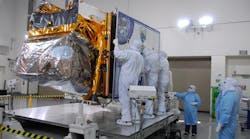The National Aeronautics and Space Administration has extended a contract with Northrop Grumman aimed at creating satellites systems to sift the atmosphere for temperature and humidity data.
The technology will be included on the next generation of the Joint Polar Satellite System, or JPSS, a satellite array that gathers data to assist scientists in forecasting weather patterns. The advanced technology microwave sounders (ATMS) scan the atmosphere with microwave signals, from which scientists extract high-resolution temperature and humidity data.
Using 22 microwave channels, the ATMS measures the temperature within 1 degree Kelvin in one-kilometer slices of the atmosphere and moisture within 15% in two-kilometer layers. Combining data from an instrument called the cross-track infrared sounder (CrIS), scientists can build three-dimensional profiles of atmospheric temperature, water vapor, and other gases.
The new scanners will be significantly more powerful than previous technology, combining the channels used by three different microwave sensors into one instrument, gathering much more detailed data. The raw data is processed in ground stations, where scientists from the National Weather Service and National Hurricane Center filter the data into weather models, helping them predict storm tracks and precipitation.
The satellites in the JPSS constellation orbit the earth from pole-to-pole, as opposed to geostationary satellites that orbit around the earth’s equator. The satellites fly over the equator 14 times every day, scanning the entire atmosphere twice a day. In recent years, the satellite data has helped scientists understand major climate shifts caused by greenhouse gas emissions.
Over the last few years, NASA has strengthened its ties with the NOAA to advance research into severe—but poorly understood—weather patterns. Last year, the space administration began testing a series of eight microsatellites that redirect GPS signals to track the evolution of hurricanes. The National Severe Storms Laboratory is also using multi-function phased-array radars for a new weather surveillance system.
The ATMS instruments will be placed on JPSS-3 and JPSS-4, the fourth and fifth satellites in the next generation of the JPSS constellation. An ATMS instrument is currently aboard the Suomi-NPP satellite, the first satellite launched as part of the new system. NOAA and NASA are planning to launch the second satellite, called JPSS-1, in early 2017.
